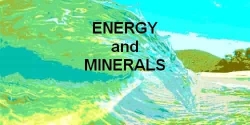Olympic Dam Deposit
Olympic Dam Deposit - Iron Oxide (Cu-U-Au-LREE) Deposits
Adapted to HTML by Earth Science Australia from Murray W. Hitzman, White House Office of Science and Technology Policy Introduction
Age
Tectonic setting
Mineralogy
Alteration
Regional Variation of deposits
Other Examples of Olympic Dam-type deposits

Introduction
Olympic Dam-type iron oxide (Cu-U-Au-LREE) constitute a distinct class of ore deposits characterised by iron-rich, low-titanium rocks formed in extensional tectonic environments.These deposits formed primarily in shallow crustal environments (<4-6 km) and are expressions of deeper-seated, volatile-rich igneous-hydrothermal systems, tapped by deep crustal structures.
- The Olympic Dam Cu-U-Au-Ag ore deposit of South Australia occurs in a tectonic-hydrothermal breccia complex that is surrounded by Mesoproterozoic granite.
- The breccia is composed mainly of granite clasts and minor amounts of Mesoproterozoic volcanic clasts.
- Very thick (>350 m) sections of bedded sedimentary facies that occur in the breccia complex include laminated to very thin planar mudstone beds, thin to medium internally graded sandstone beds, and thick conglomerate beds.
- The bedded sedimentary facies extend continuously across a 1.5 km × 0.9 km area and are not limited to small separate maar craters.
- Detrital chromite and volcanic quartz in the bedded sedimentary facies cannot be matched with local sources, and imply that the provenance extended beyond the area of Olympic Dam.
- The lateral continuity, provenance characteristics, great thickness, below-wave-base lithofacies, and intracontinental setting suggest that the bedded sedimentary facies are remnants of a sedimentary basin that was present at Olympic Dam prior to formation of the breccia complex.
- The Olympic Dam hydrothermal system operated beneath and partly within an active sedimentary basin, was not confined to maar craters, and did not vent.
- This view of the setting raises the possibility that sedimentary processes were involved in ore genesis
(1.)Age
The majority of known deposits, particularly the larger examples, are found within Early to mid-Proterozoic host rocks (1.1 - 1.8 Ga). However, examples are recognised into the Tertiary.(2.)Tectonic setting.
The deposits are located in areas that were cratonic or continental margin environments; in many cases there is a definite spatial and temporal association with extensional tectonics. Most of the districts occur along major structural zones, and many of the deposits are elongated parallel to regional or local structural trends. The host rocks may be igneous or sedimentary; many of the deposits occur within silicic to intermediate igneous rocks of anorogenic type. However, mineralisation in many deposits is not easily related to igneous activity at the structural level of mineralisation.(3.)Mineralogy
The ores are generally dominated by iron oxides, either magnetite or hematite. Magnetite is found at deeper levels than hematite. CO3, Ba, P, or F minerals are common and often abundant. The deposits contain anomalous to potentially economic concentrations of LREEs, either in apatite, or in distinct LREE mineral phases.(4.) Alteration
The host rocks are generally intensely altered. The exact alteration mineralogy depends on host lithology and depth of formation, but there is general trend from sodic alteration at deep levels, to potassic alteration at intermediate to shallow levels, to sericitic alteration and silicification at very shallow levels. In addition, the host rocks are locally intensely Fe-metasomatised.Regional Variation of deposits
In spite of these similarities, many variations occur between and within individual districts, particularly in deposit morphology. Individual deposits occur as strongly discordant veins and breccias to massive concordant bodies. Both the morphology and extent of alteration and mineralisation appear to be largely controlled by permeability along faults, shear zones and intrusive contacts, or by permeable horizons such as poorly welded tuffs. Local variations in mineralogy and geochemistry may be largely attributable to wall-rock composition, and to P, T, and ƒO2 controls related to depth of formation.Other Examples of Olympic Dam-type deposits
Examples of Olympic Dam-type deposits are found in the Wernecke Mountains of eastern Yukon Territory and in the western portion of the Northwest Territories.The Wernecke Mountains contain approximately 90 discrete breccia bodies which are concentrated along the Richardson Fault Array, a major fault zone that controlled block faulting from the mid-Proterozoic to the Tertiary. The breccias cut the Proterozoic Wernecke Supergroup, a >4.5 km thick section of marine sediments.
All the breccia bodies contain minor to significant amounts of iron oxide. Sulfide mineralisation appears to be a late-stage event in all the breccia bodies. In the deeper breccias, chalcopyrite replaces magnetite and is intergrown with, or replaces pyrite and hematite. In stratigraphically higher breccias, chalcopyrite is veinlet-controlled and disseminated, as either replacements of magnetite or as interstitial grains within carbonate or specular hematite.
Uranium minerals and gold commonly occur on the periphery of breccia bodies. LREEs in the Wernecke breccias are concentrated in apatite and monazite. Isotopic studies suggest that the hydrothermal fluids responsible for alteration and mineralisation in these breccia bodies had near magmatic compositions.
Though the Olympic Dam-type deposits constitute major sources of iron (Kiruna, Chilean Fe), only two deposits are currently exploited for other metals (Olympic Dam - Cu, Au, U; Bayan Obo -LREE). The variability of Cu-U-Au-LREE contents within this deposit class, combined with potentially difficult metallurgy, makes these deposits a high risk exploration target. However, these factors are partially offset by the large size potential of these deposits.

